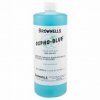Load Master
Member
RUGER GP100 with a couple of small rust spots on the bluing. What is the best way to remove the rust and to treat the spot after word try and match the original bluing? Thanks....
I have used Kroil with 0000 steel wool to remove surface rust.
Naval Jelly and the like are very effective in removing blueing. In fact they will remove the blueing even before they attack the rust. My last foray in this was to remove the blueing from a Civil War socket bayonet that had been blued. Worked like a charm.Various brews containing phosphoric acid suck the oxygen out of the rust, leaving the iron.
Brownells makes one specifically for guns. Navel Jelly is a relatively mild one. Dupont makes some very strong ones for automotive body work.

I have used Kroil with 0000 steel wool to remove surface rust.

Greetings
ATF (automatic transmission fluid) is the liquid we use. .Excellent penetrating oil that also lubes and nutralizes corrosion. Let it sit a couple house and soak in well.
We start the "rub" with a common "green kitchen pad (no scouring powder). Apply pressure as needed.
If the green pad did not get it then the finest wool we have lightly applied. Patience will aid you here.
Mike in Peru
Various brews containing phosphoric acid suck the oxygen out of the rust, leaving the iron. ...
 Are you aware that bluing is a form of "rust"?
Are you aware that bluing is a form of "rust"?